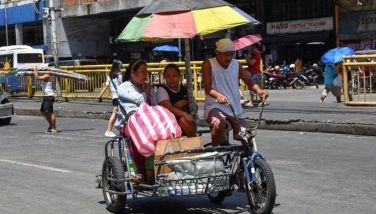Land mines hamper rescue of 27 hostages in Basilan
ZAMBOANGA CITY - Military troops tasked to rescue 27 hostages held by the Muslim extremist Abu Sayyaf group moved cautiously as they approached the rebels' main camp in the hinterlands of Basilan which is believed to be surrounded with hundreds of land mines.
Maj. Gen. Diomedio Villanueva, chief of the Armed Forces' Southern Command (Southcom), said the military and Special Action Force policemen uncovered at least three land mines in the jungle near the camp. The land mines, he said, were made of dynamite sticks and timing devices.
"The boys are taking it slow. The land mines are hampering their movements," he said.
Three MG-520 helicopters pounded defense bunkers around Camp Abdurazzak, the main Abu Sayyaf lair on Mt. Punoh Mahajid in Sumisip, Basilan.
Villanueva said the rocket-firing helicopters have to destroy the bunkers and drive away the rebels guarding them so ground troops can penetrate the camp and rescue the hostages.
Results of yesterday's air strikes were not immediately known but fighting was continuing on the ground.
Villanueva refused to set a deadline for the siege which is also being slowed down by intermittent rains and the rugged terrain.
"An operation like this is open-ended. This is not an urban-type warfare where you just keep on advancing. There are many variables here and we need to ensure the safety of the hostages. We have to give the hostages the chance to survive," he stressed.
The Southcom chief, however, said that the siege will stop only if the rebels surrender. "The only thing that would stop us is if they surrender. What is best is that they release the hostages and we'll talk later," he said.
At Malacañang, Press Secretary and Presidential Spokesman Ricardo Puno said the military was prepared to downscale its operation if the rebels yield.
"There is a chance that there can be some downscaling of operations given concrete proposals from the other side," Puno said.
About 1,500 soldiers and elite policemen were taking part in the assault, which was launched Saturday or three days after the Abu Sayyaf said it had beheaded two of their 29 hostages, both male teachers, and threatened to kill more of their captives, including a Catholic priest, teachers and dozens of school children.
The reported executions occurred after the government rejected the rebels' demand to release three Islamic militants being held in the United States. Among these militants is Youssef Ramsy or Ramzi Ahmed Yousef who had been convicted of masterminding the 1993 bombing of the World Trade Center in New York.
The military put its losses at three dead and four wounded in the skirmishes on the slopes of the 900-foot Mt. Punoh Mahajid.
In Manila, Defense Secretary Orlando Mercado said he has received reports that the rebels were using their hostages as "human shields" in an attempt to foil the military's assault.
There were reports that the rebels even tied their hostages on trees to prevent the military from attacking and that a teacher and a child had been wounded in the siege.
Such reports, however, could not be independently confirmed.
"The Abu Sayyaf are in bunkers while the hostages are in huts above them. They are using the hostages as human shields," Mercado said. "We're holding our breath over what might happen to the hostages. That's our problem."
As this developed, Autonomous Region in Muslim Mindanao Gov. Nur Misuari was saddened by reports that among the soldiers killed in the assault were former Moro National Liberation Front (MNLF) fighters who have been made part of the military.
Misuari met with Southcom leaders Sunday to assess the situation in Basilan. He allegedly expressed grief over the death of his former wards, but at the same time showed pride that the former guerrillas had joined the government in fighting lawless elements.
The MNLF used to be the biggest secessionist group in Mindanao until 1996 when it signed a peace accord with the government.
In another development, armed men believed to be members of the Abu Sayyaf threw grenades and faired automatic rifles at a military camp in Jolo, Sulu Sunday morning, seriously wounding at least six soldiers.
Reports reaching the Southcom headquarters here said the wounded soldiers were all assigned to the 4th Infantry Battalion.
Superintendent Candido Casimiro, head of the Sulu police, said the soldiers were rushed to Camp Astureia hospital for treatment.
"We do not know who were the attackers, but we suspect they could be Muslim rebels," Casimiro said, adding that security forces in the province had stepped up offensives against the Abu Sayyaf which have been holding a bank teller and an accountant captive since February in Sulu island.
The military believed the attack could be a ploy of the rebel group to divert the military's attention from its rescue operation in Basilan.
The Abu Sayyaf, with an estimated strength of about 1,000 fighters, is the smaller of the two groups fighting for a separate Islamic state in Mindanao.
One of the group's members was allegedly seized by vigilantes in Basilan Saturday and beheaded, apparently in retaliation to the earlier decapitation of two of the Abu Sayyaf's hostages.
Mercado said he condemned the act since it was like "throwing gasoline to the fire."
"It would only complicate the matter. We're appealing to them (vigilantes) not to interfere and to let the military solve the problem," he said. -- With Marichu Villanueva, Efren Danao, Perseus Echeminada, AP, AFP, Reuters
- Latest
- Trending






























